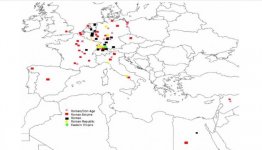Angela
Elite member
- Messages
- 21,823
- Reaction score
- 12,329
- Points
- 113
- Ethnic group
- Italian
Of course ancient Germans could be more similar to Welsh than today's Germans; the last 2000 years have left a lot of admixture in Europe. About the isotopes this theme it's quite new to me but the testings done are allways local, there are not comparisions with other European regions so my doubt is yet there... moreover after reading in Supplementary:
1.2.3 Carbon and Nitrogen Stable Isotope Results
δ 13 C and δ 15 N values of five of the genotyped individuals fall within or marginally outside (6DRIF3) ±2
SD of the mean for RomanoBritish humans from York (n=173) (Supplementary Fig. 4). These data are
consistent with the local RomanoBritish diet which was very predominantly based on terrestrial
C3 resources, but probably with small contributions of marine protein to the diet of at least parts of the
population 7,8 . Two of the individuals (3DRIF26 and 6DRIF18)
have dentine δ 15 N values which are higher than the York mean +3 SD (or further than 1.5 interquartile ranges from the median).
Consequently, neither individual was consuming the typical York diet, at the time when the sampled tooth
roots were forming, between c. 7 and 14 years of age 71. Indeed, the two datapoints are equally unusual
when compared with the sizeable human dataset available from all of Roman Britain (mean δ 13 C 19.6
±0.7 and δ 15 N 10.2 ± 1.3‰ (1 SD)).
Maybe this difference could be explained by the different gladiator's diet, or maybe that their diet was from another region. All is under doubts.
I'm not sure that I follow; the diet was consumed when they were children, and the foods weren't grown in England, or even in Europe for some of them.
Sample 3DRIF26 is the Syrian (or Nabataen) autosomally, so his results make sense. I'd like to know the yDna of sample 6DRIF18 and if he was one of the millet eaters.
Ed. Isn't 6DRIF18, one of the two "foreigners" in this tested group, the only one of the Iron Age and Roman era samples who is blonde and blue eyed?




